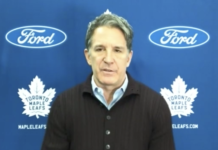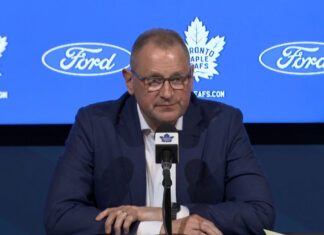MLHS’ Alec Brownscombe chatted with Maple Leafs Director of Pro Scouting Steve Kasper this afternoon. Topics covered include the process of pro scouting, the new off-season additions, and how the Leafs stack up at centre compared to the rest of the league. Enjoy.
Alec Brownscombe: What does the job of Director of Pro Scouting of the Maple Leafs involve on a day-to-day basis?
Steve Kasper: I stay in touch with [pro scouts] Mike Penny, Rob Cowie and Tom Watt, as well as Dave Poulin, Claude Loiselle and Dave Nonis. We’re basically out watching games. Pretty much every night one of us is out there, and most nights all of us are out there. Basically, we are collecting information. We’re looking at predominantly the NHL and the AHL, and just keeping a database on players – making a list of players we feel are playing really well and we like, and maybe players we are not as interested in.
AB: Obviously there’s a lot more scouts on the amateur side, with 12+ scouts on that side, why is the number three the right number of pro scouts?
SK: Just logistically, look at how many teams the amateur guys have to cover. The National Hockey League has 30 teams and the AHL has the equivalent. It’s a lot easier than it is covering all of Quebec, all of Ontario, all of Western Canada as well as the the US college system and the USHL, and all the amateur teams throughout the world. It’s a much smaller ground to cover. Keep in mind we do have a European pro scout also in Jari Gronstrand, so we do cover a little more ground with that. But there’s far more amateur teams and a far bigger territory to cover.
AB: Does the pro scouting staff measure players with anything other than their “eyeballs”? Does the team use any statistical metrics within their database of players?
SK: No, we are not using a statistical analysis. I am not saying there’s not room for that in the game, but sometimes a player’s contribution does not always show up on a stat sheet. I know a statistical analysis isn’t simply looking at goals and assists, but sometimes a player can play his best game and you don’t see his name anywhere on the scoresheet. My own personal belief is that I like to be there live and see a game myself.
AB: When the management group identifies an organizational need, would they go to you and say “give us a shortlist of players to fill this need,” or how does it work?
SK: I think every situation is different. There isn’t one set of criteria that is used all the time. First of all, it’s easy to identify need but, similar drafting to players, if you have an opportunity to get a player that is going to help make your team better then you’re going to look at it. I won’t just say, “let’s just look at a center,” or defencemen or winger or a goaltender. I think Dave Nonis is always looking at ways to make the Maple Leafs better. With that said, if he is looking for a specific category, we might talk about just who we think is out there, who may be available, who can help us, and why. An awful lot of discussion amongst the group goes into coming up with a decision on who may help us or who may not be able to help us.
AB: When it comes to the acquisition of a Jonathan Bernier, would the goalie guys on the amateur side in Garth Malarchuk and Mike Palmateer be consulted?
SK: That’s not my job to consult with them. Certainly Dave Nonis can consult with anyone throughout the organization and get a view on someone’s progress based on what some of the amateur people thought of them. Basically, once they turn professional they’re handed off and then the pro side starts watching them. A player like Jonathan Bernier obviously played for a couple of years in Manchester, New Hampshire for LA’s farm team before moving on to the Kings. We have been watching him from that point on.
AB: What stood out to you and your team about Bernier?
SK: Our evaluation has been very positive on him. He seems to be a great competitor who has demonstrated the ability to keep his team in hockey games and be very steady while doing so. We just made the determination that there is very good upside there.
AB: How involved were you in the trade for Bolland and the FA acquisition of Clarkson?
SK: Dave Nonis obviously makes the final determination on anything that goes on in the organization. We’re consulted and we give our opinion. Dave accumulates all of the data and all of the information and makes his decision. I saw Bolland, and so did Mike Penny and Rob Cowie and Tom Watt. We’re out there watching all the time, and certainly Claude Loiselle and Dave Poulin are out there watching games as well. It’s not just when teams come in to play the Leafs or the Leafs are on the road… we all watch a lot of games.
AB: Bolland had a bit of a down year despite ample PP time and the opportunity to play with some good linemates in Chicago. What makes the team confident he’ll bounce back? Do you think that 2nd line scoring role was an improper one for Bolland?
SK: Well, first of all, I don’t know who is making the determination that he had a down season. You didn’t hear that from me. Obviously Chicago had a very successful year winning the championship, but were also very successful from the day the puck was dropped to the final faceoff. I just think Bolland was a regular contributor to that team, and a big contributor to that team. You didn’t hear me say he had a down year. My job is not to define his role. The coaching staff assembles the team and plays them in the role that they see fit to help Toronto win. In Dave Bolland we have a very versatile player who can contribute in all three zones, and can play in all game situations. I’m sure Randy Carlyle and the coaching staff will find the best way to utilize his skillsets.
AB: When it comes to a pending FA like Clarkson… if we take it back to the season, he may or may not be available in a few months. Do you scout a prospective UFA like him more closely knowing he could become available, or rely on an internal database of scouting info? I’d imagine that during a season, if a trade target is being discussed, your team can get out and see that player for a few viewings right away. How does it work with FAs or trade targets in the off season?
SK: Certainly, during the course of the season we are trying to get a good feel for everyone playing in the league. Obviously, once the trade deadline passes, then it’s a little easier to narrow your focus to look at pending free agents because there will be no more movement before the end of the season. It just gives you an opportunity to take a little closer look at everyone out there who may be becoming a free agent in the latter part of the season.
AB: Sticking with Clarkson, Nonis has said that he doesn’t have to score 30 to justify the contract. Specifically, what are the other elements the pro scouts loved about David?
SK: I’ll go back to what I told you about Dave Bolland. To win hockey games you need a lot of things to happen, it’s not just scoring goals. A lot of coaches will ask you the question, “if you’re not scoring for me, what is your contribution?” When you look at a David Clarkson, you are looking at a solid team player who shows up to play every game and gives maximum effort every shift. He’s effective along the wall, he goes to all the tight, difficult, dirty areas of the ice – the front of the net – and makes himself hard to play against. That all contributes to a team winning hockey games.
AB: A quieter addition on July 5 was TJ Brennan, who played 30 games in the NHL last season between Florida and Buffalo. Describe his game and if you think he could be a factor this season.
SK: I think TJ Brennan has a lot of upside potential. He was a dominant player in the American Hockey League. If you watched him play there, he was very aggressive offensively and defensively. He was very active and involved in the play. I think it’s up to him to take that next step, to carry over the way he played in the AHL to the NHL. Certainly in his limited stints in the NHL last year he showed signs of it. We just believe that he’s putting in the right effort and that there’s potential there to take the next step and do it on a regular basis.
AB: The Leafs rejigged their personnel at center ice, re-upping Bozak, buying out Grabovski and bringing in Bolland. Being highly familiar with the 29 other teams, where do you think the Leafs stack up down the middle?
SK: I think we are very competitive down the middle. I think that it’s a mistake to characterize a player as a number one center or a first line center or a second line player. I think on any given night, whatever line is ‘going’ the coach could deem fit to utilize as his number one line. I think that we’re developing great depth through the middle and in any given game, from the first line to the fourth line, that gives the coach a lot of different options as to how to utilize his players to get the most out of them. As an organization, starting right at the center spot, I think we’ve created a healthy competition amongst ourselves in terms of players vying for the ice time.




































